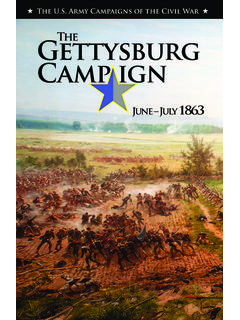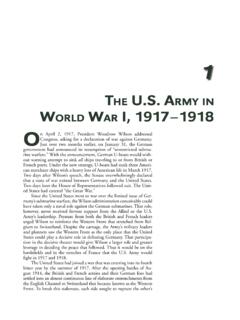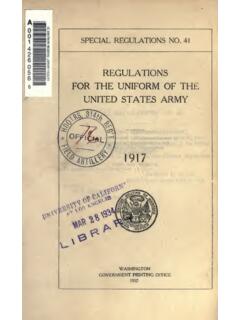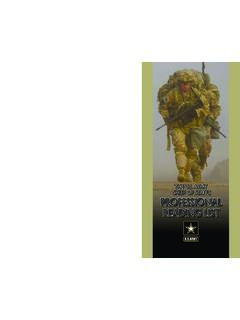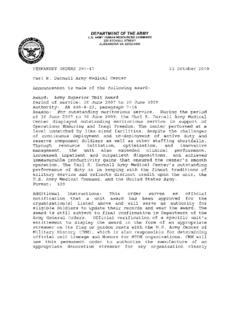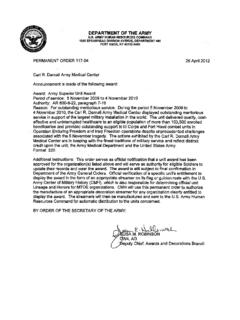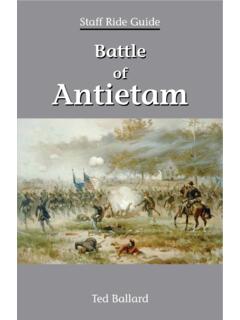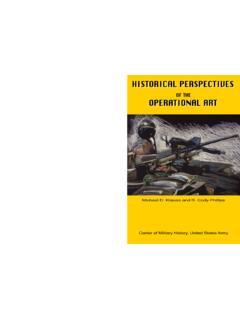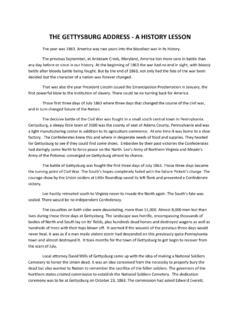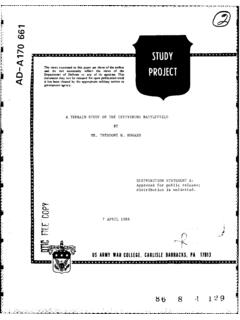Transcription of CETTYS URG ST FF RI E - history.army.mil
1 CETTYS URG ST FF RI E BRIEFING BOOK ARMY CENTER OF MILITARY HISTORY FOREWORD Buford came to gettysburg late one night Riding west with his brigades of blue horses, While Pettigrew with his North Carolinians Were moving east toward the town with a wagon-train, Hoping to capture shoes. The two came in touch. Benet, John Brown's Body If neither General Meade nor General Lee planned to fight at gettysburg , how did it happen that the first three days of July 1863 were to become arguably the most important span in the Civil War? That question cannot be fully answered without viewing McPherson's Ridge or Oak Hill, nor can one really understand the urgency of Chamberlain's bayonet charge nor the audacity of Pickett's division at the Angle without visiting those places. Accordingly, the purpose of a gettysburg staff ride is to visit these and other locations on the battlefield and analyze the battle through the eyes of the men who were there, both leaders and rank and file soldiers.
2 Hopefully, by understanding the actions, inactions and reactions of commanders and their troops in real situations we may gain insights into the human condition under stress and decision making during combat. In 1906, Major Eben Swift took twelve officer-students from Fort Leavenworth's General Service and Staff School to the Chickamauga Battlefield on the Army's first staff ride. Since then staff rides have been used to varying degrees in the education of Army officers, usually in the formal school system to add realism to training and narrow the gap between peacetime and war. The staff ride, therefore, not only assists participants to understand the realities of war, it is mental training for warfighting. Indirectly, it enhances unit readiness. In summary, the staff ride is a training method which commanders can use for the professional development of their subordinates and to enliven the unit's esprit de corps -constant objectives of all commanders in peacetime.
3 At some time in their careers most officers have memorized the in-vogue principles and maxims of military art, probably without fully understanding or analyzing them. Now, whether you think of yourself as a tactician, operational artist, strategist, or just a soldier as you walk the battlefield, you should search for those principles and human characteristics which do not change over time. Place yourself in the minds of the leaders in the battle, analyze their decisions and determine if they could have done better. In this way you can fix in your mind the principles and thought processes that must be second nature to you in the crisis of combat. We are convinced that the staff ride is the one of the best ways to do this. Billy Arthur Ted Ballard TABLE OF CONTENTS "The gettysburg Campaign" .. 1 Order of Battle - Army of the Potomac ..15 Order of Battle - Army of Northern Virginia ..23 Casualties.
4 29 Organization ..30 Logistics .. 32 Small Arms ..35 Artillery ..37 Tactics ..42 gettysburg weather reports ..44 Selected Biographical Sketches of Union Leaders: Lincoln ..46 Stanton ..48 Halleck ..49 Meade ..50 Chamberlain .. 52 Hancock ..53 Howard ..54 Reynolds ..55 Sedgwick ..57 Sickles ..58 Slocum ..59 Sykes ..61 Selected Biographical Sketches of Confederate Leaders: Davis ..62 Lee ..63 Ewell ..65 Hill, A. P..66 Longstreet .. 67 Pickett ..68 Stuart .. 69 Map - United States in 1861 .. 71 Chronology of Events of the Civil War - 1863 ..72 Chamberlain and the 20th Maine at Little Round Top ..73 Selected reports and cables .. 87 ii THE gettysburg CAMPAIGN "Extracted from The West Point Atlas of American Wars, Volume I, 1689-1900, and printed with permission of the Department of History, Military Academy." FOR INSTRUCTIONAL PURPOSES ONLY Following the Battle of Chancellorsville, Hooker's and Lee's contending armies resumed their former positions along the opposite banks of the Rappahannock River.
5 Hooker was temporarily restricted to the mission of ensuring the safety of Harpers Ferry and Washington. On the Confederate side, morale was at its highest pitch. Chancellorsville had been a deceptive victory; a feeling of invincibility spread through the Army of Northern Virginia. It was now a far stronger army than the one Hooker had faced at Chancellorsville. The Confederacy's conscription enabled Lee to fill up his weakened veteran regiments, and new, relatively untrained regiments were brought up from the Carolinas. Accordingly, he had reorganized the Army of Northern Virginia into three infantry corps--commanded respectively by Longstreet, Ewell, and A. P. Hill--and Stuart's oversized cavalry division. (It might be well to note here that, for at least the first three years of the war, the average Southern corps and division had almost twice as many men as their Northern counterparts.)
6 Each division now had its own battalion of artillery. The whole organization was efficient and flexible, but the excellent combat units were not backed up by well-organized staffs or an efficient service of supply. The over-all military situation shown here was not promising for the Confederacy. The Army of the Potomac was still strong, and Lee knew that it was only a matter of time until it would launch a new offensive. The Federal naval blockade was becoming increasingly tight, and one after another of the Southern seaports was being occupied in a series of minor amphibious operations. Though such expeditions drew troops from the main Federal armies, they also pinned down almost equal numbers of Confederates and provided beachheads from which attacks inland might be launched. In the center, Rosecrans and Bragg neutralized one another for the time being, but the war along the Mississippi River was definitely being lost by the Confederacy.
7 Grant, after several failures, had driven Lt. Gen. John C. Pemberton into Vicksburg, where he now held him under siege. Downstream, New Orleans had been captured by Rear Admiral David G. Farragut in April, 1862, and now Banks (of Shenandoah Valley experience) was besieging Port Hudson. Only between Vicksburg and Port Hudson could the eastern and western sections of the Confederacy maintain a tenuous connection--and this only in the absence of prowling Federal gunboats. Lee had skillfully defended the Confederacy's front door, but behind him various Federal commanders were steadily making serious inroads. There were operations in minor theaters. Pope was stamping out a major Sioux uprising. War with other tribes flickered across the trails to California, killing soldiers as effectively as Chancellorsville or Shiloh (and sometimes far more brutally). In Missouri, Kansas, and Arkansas, an even more savage guerrilla struggle smoldered; neither side fought a 1 "gentlemen's war," the Confederate effort in particular being tainted by gangs of professional criminals, such as that of Charles Quantrill.
8 In Virginia, Longstreet weighed the situation of the Confederacy and offered a solution--to consider the war as a whole, instead of as a series of separate theaters. He reasoned: the South still retained interior lines and could therefore shift troops by railroad from one theater to another faster than the Federals could; Lee could leave Ewell and Hill to contain Hooker, move west with Longstreet's corps and all other available eastern troops, incorporate Bragg's, Buckner's, and Johnston's forces into his army, and throw the whole against Rosecrans; a victory there would paralyze the North; Grant undoubtedly would be recalled from Vicksburg. This proposal had possibilities, though it overrated the capabilities of the Confederate railroads. But Lee had gone to war primarily to defend Virginia, and he hesitated to concern himself with matters outside the area of his command. Lee's own plan was simple: defensive strategy would never win the war; therefore, invade the North.
9 Hooker's position was too strong to attack, but the threat of an invasion would force him to leave it. That done, Lee was confident of inflicting a decisive defeat upon him which might end the war. Also, between natural shortages and chronic ineptness of the Confederate supply system, Lee's troops were in constant want. Across the river, in Maryland and Pennsylvania, there were ample resources of food and clothing. So Lee began shifting his army quietly westward for an advance up the Shenandoah and Cumberland Valleys. By holding the passes in the Blue Ridge and South Mountains, he could both screen his advance and protect his supply line. A. P. Hill's corps remained around Fredericksburg, spread thin to keep Hooker thinking that the whole Confederate army was still there. Hooker's nerve might fail in a crisis, but he had the instincts of a good commander, and his staff included an efficient intelligence section.
10 By late May, he had indications of Lee's general plan. His first reaction (5 June) was to cross the river as soon as Lee moved west and to attack A. P. Hill. His second inspiration (10 June) was to move directly on Richmond. Lincoln and Halleck vetoed both plans, stating that Lee's main army must be the objective. On 5-6 June, Hooker sent Sedgwick across the river to test the Confederate strength in the Fredericksburg area. Hill reacted aggressively and convinced Sedgwick that the main Confederate army was still there. Dissatisfied with this report, Hooker ordered Pleasonton (now commanding the Cavalry Corps) on a reconnaissance toward Culpeper Stuart's cavalry division lay at Brandy Station with orders to march west on 10 June. Early on 9 June, Pleasonton suddenly arrived, taking Stuart completely by surprise. This started the biggest cavalry fight in American history--a highly confused affair with some 10,000 sabers on each side.
